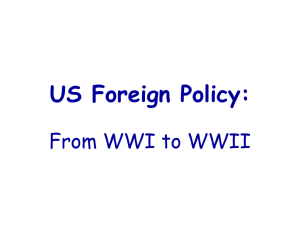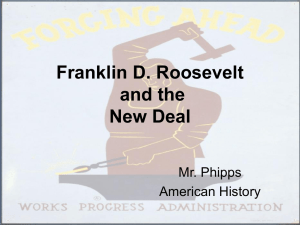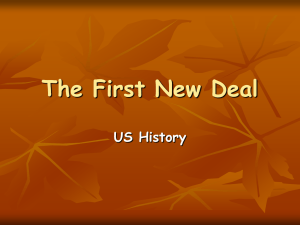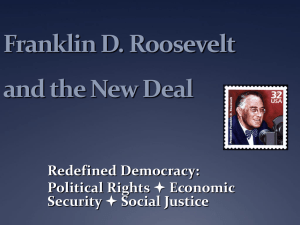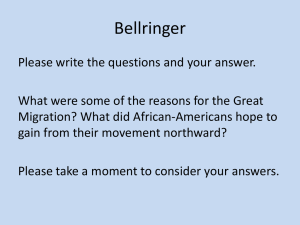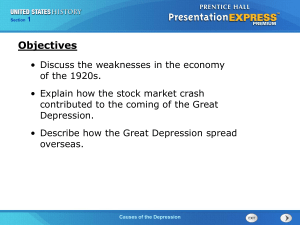THE GREAT DEPRESSION AND NEW DEAL
advertisement
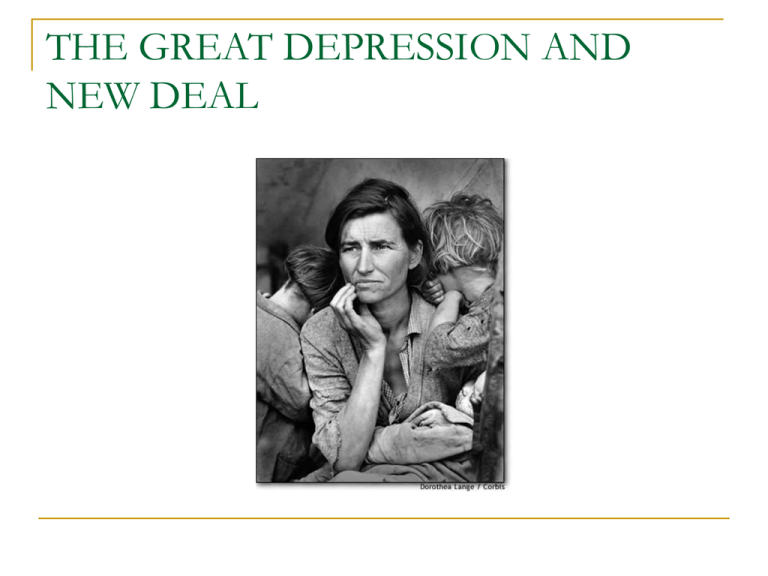
THE GREAT DEPRESSION AND NEW DEAL THE ELECTION OF 1928 THE CANDIDATES THEN CAMPAIGN OF 1928 THE RESULTS HERBERT HOOVER Organized food drives for the starving people of Belgium during WWI. Led the Food Administration Board during WWI. Successful businessman who hated socialism or large-scale federal govt., intervention in the economy. HERBERT HOOVER As Sec. of Commerce, he supported some progressive ideas e.g., endorsing labor unions and supporting federal regulation of the new radio broadcasting industry. Claimed in 1928 that “Poverty will be banished from the nation. Everybody ought to be rich.” He is an accident of history. THE GREAT CRASH OF 1929 THE GREAT CRASH OF 1929 The ever-rising stock prices had become both a symbol and a source of wealth during the 1920s. A “boom” was in full force in the USA and in the world economy in the late Twenties. On the Wall Street Stock exchange, stock prices kept rising for 18 months – 3/289/29. 9/3/29: The Dow Jones Average of major stocks had reached an all-time high of 381. An avg., investor who bought $1,000 worth of stocks at the time of Hoover’s election would have doubled his/her money in less than a year. Millions invested in the boom market of 1928. THE GREAT CRASH OF 1929 Millions lost their money in October 1929, when the boom market collapsed. IMMEDIATE CAUSES OF THE GREAT CRASH OF 1929 1. The Bull Market 2. Buying stocks on margin. 3. Overspeculation. THE GREAT CRASH OF 1929 Although stock prices had fluctuated greatly for weeks preceding the crash, the true panic did not begin until Thursday Oct. 24, 1929. Black Thursday: Saw an unprecedented volume of selling stocks and prices plunged. THE GREAT CRASH OF 1929 Hoping to starve off disaster, a group of bankers bought millions of dollars of stocks in an effort to stabilize prices. This worked for one business day – Friday. The selling frenzy resumed on Monday Oct. 28, 1929. BLACK TUESAY: OCTOBER 29, 1929 Oct. 29, 1929: Black Tuesday: everybody wanted to sell their stocks. Investors ordered their stock brokers to sell when there were no buyers to be found. Within hours, the stock market crashed. BLACK TUESDAY: OCTOBER 29, 1929 From that day on, prices on Wall Street kept going down and down. By mid-November, $25 billion in stock value had disappeared. Fortunes were wiped out almost overnight. THE GREAT CRASH OF 1929 Traditional historical interpretation puts the Crash as the immediate cause of the Great Depression. However no direct connection has ever been proven. The US did not sink into a major depression until Dec. 1930. LONG-TERM CAUSES OF THE GREAT DEPRESSION 1. Weak Industries 2. Overproduction of consumer goods. 3. Uneven distribution of income. 4. Unstable banking system. 5. Stock market speculation. 6. Excessive use of credit. 7. Weak farm economy. 8. Government policies. 9. Global economic problems. EFFECTS OF THE GREAT DEPRESSION EFFECTS OF THE GREAT DEPRESSION EFFECTS OF THE GREAT DEPRESSION EFFECTS OF THE GREAT DEPRESSION EFFECTS OF THE GREAT DEPRESSION EFFECTS OF THE GREAT DEPRESSION EFFECTS OF THE GREAT DEPRESSION The Great Depression was the longest and most devastating in US history. USA hit the hardest among industrialized nations. GNP fell from $104 billion in 1929 to $56.1 billion in 1933. HOOVER’S RESPONSE TO THE GREAT DEPRESSION Hoover believed that outside forces in Europe were responsible for the Great Depression: International reparations and war debts structure collapsed. Post-war military alliances and doubling of war armaments. Unbalanced budgets and increasing debt. FARMING 1929: Agricultural Marketing Act. 1930: Federal Farm Board. Harley-Smoot Tariff of 1930. ECONOMIC RECOVERY Hoover believed voluntary cooperation would enable the country to overcome the Depression. He urged businesses to avoid lay-offs and wage cuts. He urged all citizens to contribute to charities to ease the suffering. But private charity was not enough to meet the country needs. PUBLIC WORKS PUBLIC WORKS RELIEF FOR THE NEEDY Hoover refused to support public relief programs. He vetoed use of federal funds for relief for the needy. He believed that govt., handouts would destroy the nation’s work-ethic. He compromised by authorizing the RFC to lend $300 million to states for relief. THE BONUS ARMY THE BONUS ARMY HOOVER: AN ASSESSMENT Advocated more direct govt., involvement than any previous president. Probably prevented a more serious collapse than did occur. Policies paved the way for the New Deal. His conservatism prevented him from going far enough to solve the worst slump in US history. THE NEW DEAL 1932-1940 THE FIRST NEW DEAL THE ELECTION OF 1932 THE CANDIDATES FRANKLIN DELANO ROOSEVELT FDR born into privilege but he would become to be beloved as the symbolic representative of ordinary citizens. His greatness lay in his willingness to do new and bold things to confront a national crisis. In his Democratic nomination acceptance speech, he promised a “new deal” for all Americans. But his campaign offered only vague hints of what a “new deal” might entail. FRANKLIN DELANO ROOSEVELT He spoke of the govt.’s, responsibility to guarantee “every man … a right to make a comfortable living.” Yet he advocated a balanced federal budget and criticized Hoover for excessive govt., spending. THE ELECTION 0F 1932 THE COMING OF THE NEW DEAL THE COMING OF THE NEW DEAL FDR conceived of the New Deal as an alternative to socialism on the left, Nazism on the right, and the inaction of upholders of unregulated capitalism. He hope to reconcile democracy, individual liberty, and economic planning. FDR did not enter office with a blueprint for dealing with the Great Depression. The New Deal was an attempt to preserve capitalism. FDR relied heavily for advice on a group of intellectuals and social workers who took up key positions in his administration. THE COMING OF THE NEW DEAL THE COMING OF THE NEW DEAL THE NEW DEAL PHILOSOPHY In his First Inaugural address, FDR declared “the only thing we have to fear is fear itself.” During the campaign he had promised to help the “forgotten man at the bottom of the economic pyramid.” During the early years of his presidency, it became clear that his New Deal programs were to serve three R’s: Relief for the people out of work. Recovery for business and the economy as a whole. Reform of American economic institutions. THE BANKING CRISIS THE BANKING CRISIS FDR confronted a banking system on the verge of collapse. As bank funds invested in the stock market lost their value and panicked depositors withdrew their money, bank after bank had closed its doors. 1933: Over 5,000 banks had failed. To restore confidence in those banks still solvent, FDR declared a “bank holiday” temporarily halting all bank operations, and called Congress into special sesssion. THE BANKING CRISIS FDR and Congress responded with the following: Emergency Banking Act Glass-Steagall Act Federal Deposit Insurance Corporation THE BANKING CRISIS FDR took the USA off the gold standard thus making possible the issuance of more money in the hope of stimulating business activity. These measures rescued the financial system and greatly increased the govt,s., power over it. In 1936, not a single bank failed. THE NATIONAL RECOVERY ADMINISTRATION THE NATIONAL RECOVERY ADMINISTRATION The centerpiece of FDR’s plan for combating the Great Depression, the National Industrial Recovery Act was modeled on the War Industries Bd., of WWI. FDR called it “the most important and far-reaching legislation ever enacted by the American Congress. THE NATIONAL RECOVERY ADMINISTRATION The Act established the National Recovery Administration (NRA) which would work with groups of business leaders to establish industry codes setting standards for output, prices, and working conditions. THE NATIONAL RECOVERY ADMINISTRATION GOVERNMENT JOBS GOVERNMENT JOBS The First Hundred days brought the govt., into providing relief to those in need: The Economy Act Federal Emergency Relief Administration (FERA) Civilian Conservation Corps (CCC) Public Works Administration (PWA) Civil Works Administration (CWA) Tennessee Valley Authority (TVA) CIVILIAN CONSERVATION CORPS PUBLIC WORKS ADMINISTRATION TENNESSEE VALLEY AUTHORITY THE NEW DEAL AND AGRICULTURE THE NEW DEAL AND AGRICULTURE The New Deal addressed the plight of farmers with the: AGRICULTURAL ADJUSTMENT ACT: It authorized the govt to try to raise farm prices by setting production quotas for major crops and paying farmers not to plant more. The AAA succeeded in significantly raising farm prices and incomes. But not all farmers benefitted. Benefits flowed to property owning farmers, ignoring the large number who worked on land owned by others. THE NEW DEAL AND AGRICULTURE The AAA policy of paying land-owning farmers not to grow crops encouraged the eviction of poor tenants and sharecroppers. Many joined the rural exodus or to the farms of the West Coast. THE NEW DEAL AND AGRICULTURE THE NEW DEAL AND AGRICULTURE THE NEW DEAL AND AGRICULTURE THE NEW DEAL AND HOUSING THE NEW DEAL AND HOUSING The New Deal addressed the problem of housing through the: Home Owners Loan Corporation Federal Housing Administration (FHA) THE COURT AND THE NEW DEAL THE COURT AND THE NEW DEAL VOICES OF PROTEST UPTON SINCLAIR HUEY LONG FATHER CHARLES COUGHLIN DR. FRANCIS TOWNSEND THE SECOND NEW DEAL THE SECOND NEW DEAL Spurred by the failure of his initial policies to pull the country out of the Depression and the growing popular clamor for greater equality, and buoyed by Democratic gains in the midterm elections of 1935, FDR launched the Second New Deal. The FND had focused on economic recovery. The emphasis of the SND, was economic security – a guarantee that Americans would be protected against unemployment and poverty. THE WPA AND THE WAGNER ACT THE WORKS PROGRESS ADMINISTRATION (WPA) The WPA hired some 3 million Americans in virtually every walk of life each year until it ended in 1943. It changed the physical face of the USA. It constructed thousands of public buildings and bridges. It built over 500,000 miles of roads, and 600 airports. It built stadiums, swimming pools, and sewage treatment plants. It employed many white-collar workers and professionals. THE FEDERAL ARTS PROGRAM FEDERAL MUSIC PROJECT FEDERAL THEATER PROJECT FEDERAL WRITERS PROJECT SLAVE NARRATIVES THE WAGNER ACT THE WAGNER ACT Known as “Labor’s Magna Carta.” It brought democracy into the American workplace. It created the National Labor Relations Board. The NLRB’s role was to supervise elections in which employees voted on union representation. It outlawed “unfair labor practices,” including the firing and blacklisting of union organizers. THE AMERICAN WELFARE STATE SOCIAL SECURITY ACT OF 1935 SOCIAL SECURITY ACT OF 1935 THE SOCIAL SECURITY ACT OF 1935 FDR AND THE IDEA OF FREEDOM FDR AND THE IDEA OF FREEDOM THE ELECTION OF 1936 THE CANDIDATES THE ELECTION OF 1936 THE COURT FIGHT THE COURT FIGHT CHIEF JUSTICE CHARLES EVANS HUGHES THE END OF THE SECOND NEW DEAL Even as the Court made its peace with FDR’s policies, the momentum of the SND slowed. United States Housing Act (1937) Fair Labor Standards Act (1938) THE NEW DEAL AND AMERICAN WOMEN THE NEW DEAL AND AMERICAN WOMEN NATIVE AMERICANS AND THE NEW DEAL MEXICAN AMERICANS AND THE NEW DEAL AFRICAN AMERICANS AND THE NEW DEAL AFRICAN AMERICANS AND THE NEW DEAL AFRICAN AMERICANS AND THE NEW DEAL AFRICAN AMERICANS AND THE NEW DEAL AFRICAN AMERICANS AND THE NEW DEAL AFRICAN AMERICANS AND THE NEW DEAL THE END OF THE NEW DEAL THE END OF THE NEW DEAL THE NEW DEAL IN AMERICAN HISTORY Given the scope of the economic calamity it tried to counter, the ND seems in many ways quite limited. Social Security remained restricted in scope and modest in cost. The ND failed to address the problem of racial inequality. In some ways it actually worsened racial inequality. Yet it did have substantial accomplishments. It greatly expanded the federal govt’s., role in the American economy and made it an independent force in relations between industry and labor. THE NEW DEAL IN AMERICAN HISORY It transformed the physical environment through: Hydroelectric dams. Reforestation projects. Rural electrification. Construction of innumerable public facilities. It restored faith in democracy and made the govt., an institution directly experienced in American daily lives and directly concerned with their welfare. It redrew the map of American politics. THE NEW DEAL IN AMERIAN HISTORY It helped recast the idea of freedom to include a public guarantee of economic security for ordinary citizens and that identified economic inequality as the greatest threat to American freedom. THE NEW DEAL IN AMERICAN HISTORY Only the mobilization of the nation’s resources to fight World War II would finally end the Great Depression.




